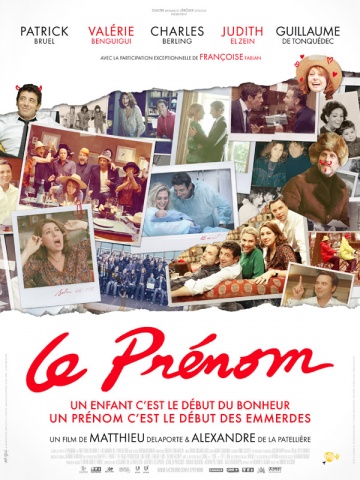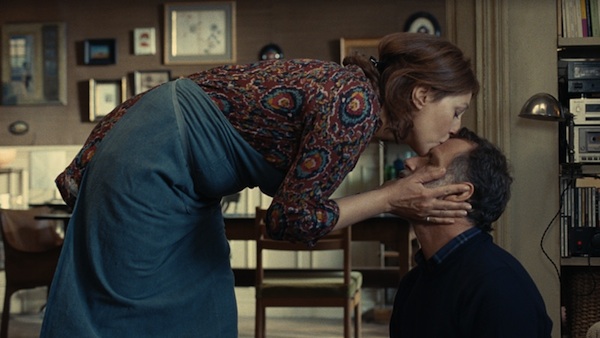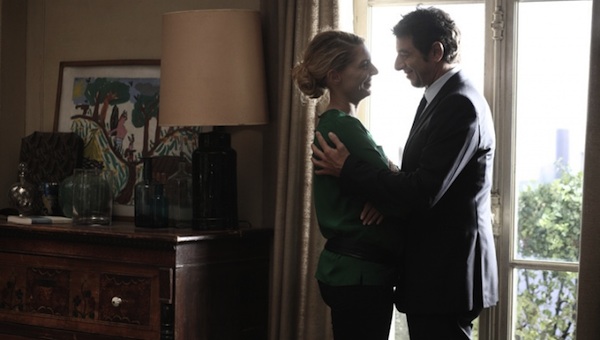 What’s in a Name, or Le Prénom in French – which actually translates as “The Given Name” – is a comedy of French farce about a dinner party that goes awry, directed by well-known screenwriters Matthieu Delaporte and Alexandre de la Patellière (Renaissance, The Prodigies). The duo adapted the screenplay from their original hit play, and with the exception of Charles Berling, the film stars all the original production’s cast members.
What’s in a Name, or Le Prénom in French – which actually translates as “The Given Name” – is a comedy of French farce about a dinner party that goes awry, directed by well-known screenwriters Matthieu Delaporte and Alexandre de la Patellière (Renaissance, The Prodigies). The duo adapted the screenplay from their original hit play, and with the exception of Charles Berling, the film stars all the original production’s cast members.
From the opening scene there is a rhythmic structure to the story that hums along quite swimmingly with the help of sharp dialog, perfectly delivered by the theatrical cast, and subtle cinematic techniques  employed by the film’s director of photography, David Ungaro. Short visual vignettes, accompanied by voiceovers from a playful narrator (Patrick Bruel), serve to introduce the story’s characters.
employed by the film’s director of photography, David Ungaro. Short visual vignettes, accompanied by voiceovers from a playful narrator (Patrick Bruel), serve to introduce the story’s characters.
There is Pierre (Charles Berling), the slightly high-strung professor at Sorbonne, and his wife Élisabeth (Valérie Benguigui) – a well-meaning yet world-weary schoolteacher who longs to make a difference through her job in education, and tolerates her mother’s (Françoise Fabian) garrulousness. They are a couple who, according to the narrator, “despite all their differences, their fortuitous flaws” will love each other every day of the week, and for the rest of their lives, a revelation that serves as a bit of foreshadowing.
Pierre and Elizabeth are the hosts of the aforementioned dinner party. The other guests include Elisabeth’s best friend, the genial trombonist, Claude (Guillaume de Tonquédec), her brother Vincent (Patrick Bruel), a well-to-do real estate agent with narcissistic tendencies and a beautiful live-in girlfriend named Anna (Judith El Zein) – who is expecting the couple’s first child and is the final member of the dinner party – she arrives perpetually late to everything in life.
Most of the action within the plot takes place in the living room of Pierre and Elisabeth’s Paris apartment, which serves as the stage in this adaptation from play to screen. There is an attention to detail in the production design by Marie Cheminal that exudes a theatrical element, hinting at the story’s origin regardless of whether or not the viewer is initially aware of the adaptation. So splendid is the result, it could be argued that every designer should approach their set design in this way. It serves as a tribute to French culture that no Francophile could resist; this apartment just screams Paris.
Mischief begins when Vincent announces the name he and Anna have chosen for their firstborn, and accelerates into a chaotic raucous of misplaced anger, the result of which is both amusing and at times disconcerting. Small truths are exposed as the evening progresses, eventually leading to a big reveal, which escalates the verbal quarrel into a physical one and threatens to destroy multiple relationships among the dinner party guests – but nothing is entirely what it seems. Forced to face their individual shortcomings, the characters learn that sometimes a little tough love now and then only makes you stronger.
The inclusion of intellectual, bourgeoisie characters invokes allusions to classical comedies of society and relationship strife ranging from the late 19th century plays of Oscar Wilde and Georges Feydeau, to modern works by directors like Whit Stillman and Woody Allen whose comedic films tackle similar themes of class structure and race using humor and wit. Through careful delivery by the actors, even the audience is pulled into the farce when an affair is discovered, and the disclosure of parties involved is momentarily delayed and obscured for dramatic effect.
Delaporte and de la Patelliére use the history of names and their meanings to explore – and sometimes criticize – societal norms and the roles people play within the family dynamic in an interesting and entertaining. Stereotypes are questioned and masks are torn off, unveiling each character’s true colors, some more surprising than others, but all of them authentic in nature. This creates a sense of realism that the superb acting by all cast members helps to perpetuate. When the characters banter one cannot help but think of their own family’s idiosyncrasies and how they play off one another.
G-S-T Ruling:
What’s in a Name is a must-see for viewers intrigued by character driven films that combine basic techniques of cinematography with thought-provoking dialogue to deliver a story that is both funny and poignant. It opens December 13 to a limited theatrical release and is also available on iTunes.




